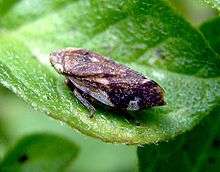Philaenus spumarius
Philaenus spumarius, the meadow froghopper or meadow spittlebug, is a species of insect belonging to the spittlebug family Aphrophoridae. In Italy and America, it is economically important as one of the vectors of Pierce's Disease (Xylella fastidiosa).[1] [2]
| Philaenus spumarius | |
|---|---|
| Philaenus spumarius, upper side | |
| Side view | |
| Scientific classification | |
| Kingdom: | |
| Phylum: | |
| Subphylum: | |
| Class: | |
| Order: | |
| Suborder: | |
| Infraorder: | |
| Superfamily: | |
| Family: | |
| Genus: | |
| Species: | P. spumarius |
| Binomial name | |
| Philaenus spumarius (Linnaeus, 1758) | |
Etymology
The genus name Philaenus comes from the Greek philein ("love"), while the species name spumarius is from the Latin spuma ("sparkling"), referring to the foam nests; the binomial Philaenus spumarius can be translated as "foam lover."
Varietas
Varietas within this species include:[3]
- Philaenus spumarius var. populellus
- Philaenus spumarius var. vittatus
- Philaenus spumarius var. lateralis
- Philaenus spumarius var. fasciatus
- Philaenus spumarius var. gibbus
Distribution
Philaenus spumarius is quite common and widespread. The species' original distribution was restricted to the Palaearctic ecozone. They are present in most of Europe, in North Africa, in part of Russia, in Afghanistan, and in Japan. They have also been introduced in North America.[4]
Identification
The species reaches a body length of 5–7 millimetres (0.20–0.28 in). Most females are slightly larger than males. In these polymorphic insects, the coloration of the body is very variable (about 20 different colors are known).[5] Usually, they are yellowish, brownish, or black, with brighter patches on a dark background, but also with dark markings on a lighter background.[6]
The most common modes of locomotion are running and flying, but the most striking is their strong jumping ability, which is useful for escaping from predators.[6][7]
Habitat
Philaenus spumarius is a very 'eurytopic' species, meaning that it can tolerate a wide range of environmental factors and therefore exist in many different habitats (parks, meadows, gardens, etc.).[6] It lives in almost all open land habitats and in open forests. It is absent only in very wet and very dry habitats.[5]
Life cycle
The seasonal nature, the phenology, of the species' life cycle varies because of the wide range of climatic conditions it can tolerate, but remains similar. In a temperate climate, the females lay eggs at the end of the summer. The eggs are laid singly or in groups (1 to 30, average 7 [8]) on the food plants of the larvae. Egg-laying is triggered by a single female, which can produce up to 350–400 eggs. In unfavorable climatic periods, froghoppers can survive in the form of eggs.[5]
Eggs are white with an orange spot; this spot becomes darker and larger if the egg is fertilised,[2] approximately 1mm long and 0.3mm wide.[9] The larvae, also called nymphs, hatch after about 20 days and develop through five stages, known as instars.
The larvae are well known for the self-generated foam nests which can be observed during spring in meadows (especially on cuckoo flowers, Cardamine pratensis, and broom, Genista, species). The larvae in the foam nests are largely protected from predators and also get the necessary moisture for the appropriate development and temperature, so their mortality remains low even in bad weather. The larval stage lasts about 50 days. The adults leave the foam nest only when it is completely dried. This takes about ten days. The females mate soon after.[5]
Froghoppers are polyphagous, their host plant specificity is low, so that they can feed on a variety of plants, mainly grasses (Poaceae species), reed plants (Juncaceae species), herbs and sometimes trees (including the olive tree, where the species has been identified as spreading Xylella fastidiosa, the bacterium associated with Olive quick decline syndrome[2]). They have been identified on over 170 host plants.[5]
Gallery
 Mating
Mating- Foam nest
 An adult, newly emerged from its foam nest
An adult, newly emerged from its foam nest Adult
Adult- A different colour form
See also
References
| Wikispecies has information related to Philaenus spumarius |
| Wikimedia Commons has media related to Philaenus spumarius. |
- Cornara, D.; Cavalieri, V.; Dongiovanni, C.; Altamura, G.; Palmisano, F.; Bosco, D.; Porcelli, F.; Almeida, R. P. P.; Saponari, M. (2017). "Transmission of Xylella fastidiosa by naturally infected Philaenus spumarius (Hemiptera, Aphrophoridae) to different host plants". Journal of Applied Entomology. 141 (1–2): 80–87. doi:10.1111/jen.12365. ISSN 0931-2048.
- YURTSEVER, S. (2000). "On the Polymorphic Meadow Spittlebug, Philaenus spumarius (L.) (Homoptera: Cercopidae)". Turkish Journal of Zoology. 24 (1–2): 447–459. ISSN 0931-2048.
- Biolib
- Fauna europaea
- Selcuk Yurtsever On the Polymorphic Meadow Spittlebug, Philaenus spumarius (L.) (Homoptera: Cercopidae)
- "Arkive". Archived from the original on 2011-08-30. Retrieved 2011-04-29.
- Jonathan Amos Garden insect is jump champion
- European and Mediterranean Plant Protection Organization (2020). "PM 7/141 (1) Philaenus spumarius, Philaenus italosignus and Neophilaenus campestris". Bulletin OEPP/EPPO. 50 (1): 32–40. doi:10.1111/epp.12610. ISSN 0250-8052.
- Weaver, C.R.; Weaver, C.R. (1954). "Meadow spittlebug, Philaenus leucophthalmus (L.)". Ohio Agricultural Experiment Station. Research bulletin. 741 (1–2): 1–99.